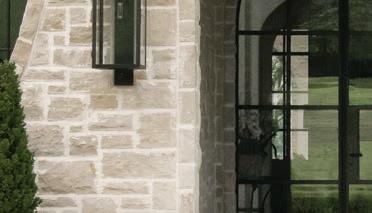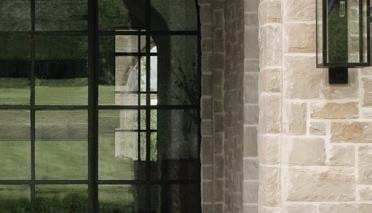
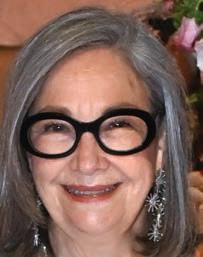







WYATT HALL’S GARDEN, TENNESSEE WETLANDS, ALAN LEQUIRE'S ‘MONUMENTAL FIGURES’ AND MORE
THE SWA N B A LL blossoms through TRA NSFO RMA TION



Located within walking distance to Radnor Lake, this perfect multi generational property is a rare fine. The home is of exceptional quality, with 9791 SF, featuring beautiful millwork, a stunning entrance, and large rooms with an elevator to all floors. Enjoy an amazing oversized pool with separate hot tub. A 2246 SF guest or pool house has 3 bedrooms, 2 full baths, a full kitchen and two living areas. There is an additional 473 SF studio with a full bath, and two commercial generators to service the entire property. The grounds are spectacular, fully fenced and gated.
1224 OTTER CREEK
3.7 Acres | $4,795,000

With lots of room to roam about, your pets will be thanking you!


Where else can you own FIVE private, beautiful acres right in the city, with a short drive to Brentwood, Green Hills, Franklin and 20 minutes from DT Nashville. is easy one level home has been smartly renovated, blending timeless charm with a cool, modern vibe. Already fully fenced this property is perfect for up to two horses complete with an existing barn, vegetable garden, herb garden, and even your own orchard. 4147 SF plus 346 SF studio with additional expansion space under roof and plenty of room to add whatever space or amenity that you would like. Co-listed with Cole Hubbard.
1702 OLD HICKORY BLVD
5 Acres | $2,500,000


















































Pilot’s Watch Performance Chronograph 41, Ref. 3883
The new Pilot’s Watch Performance Chronograph 41 is proof that performance and elegance are not mutually exclusive. The chronograph, featuring the IWC 69385 Manufacture caliber with a ceramic bezel and tachymeter scale, is now available for the first time in an 18-carat 5N gold case. The black lacquer dial is the end-product of a highly complex manufacturing process, while the appliqués are hand-set and filled with Super-LumiNova® Ten-bar water resistance and a black rubber strap with the EasX-CHANGE® system ensure maximum versatility. IWC. Engineered.









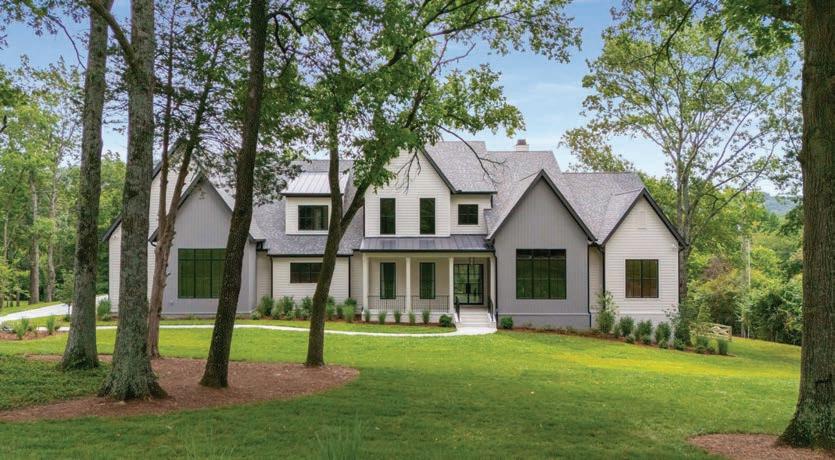

































































































































































































































Wayland Dr $5,825,000
Duncanwood Ct$3,150,000
Montrose Ave $3,011,436
Harpeth Hills $2,700,000
Chipmunk Ln $2,430,375 ompsons Station $2,250,000
Stage Coach Rd $2,240,000
Richland Ave $1,645,000 Harding Pl $1,000,000
Daventry Ct $975,000
Chickering Woods$870,000
Timber Ln $644,400
Ansley Kay Dr $600,000 omas Ave $595,000
Kintore $589,900
Winterberry Dr $550,000
Howes Place $508,000
Morgans Steep $475,000
Capers $469,000
Drysdale Dr $395,000































AUGUST 2 – 10
• An exhibition of 12 fresh floral masterpieces
• Delight in special events and floral demonstrations
• Inspired by Cheekwood’s permanent art collection
• Vote for your favorite mannequin!





































41 Zero Waste, Full Potential
1 Hotel Nashville is a guiding force for local sustainability
44 A Monumental Effort
35 years after unveiling ‘Athena,’ sculptor Alan LeQuire fills the Parthenon with inspirational figures
49 The Need for Speed Henry County, Ga., is an ideal spot for outdoorsy adrenaline junkies
53 Water World
Protecting Tennessee’s wetlands to conserve the future
59 Hidden in Plane Sight
Three landowners work with the Land Trust for Tennessee to conserve local
66 A Simple Favor
Swan Ball plants a willow oak to commemorate its first event
69 Charged Moment
The 2025 Swan Ball pulses with renewed energy
81 Going Once
The Swan Ball Auction Party delivers an action-packed evening of fundraising
84 Great Futures Start Here
The Great Futures Gala celebrates achievements by the Boys & Girls Club of Middle Tennessee
87 A Lasting Legacy
The Legacy Ball Patrons Party celebrates a future in education
89 Taking Flight
The Swan Ball Patrons Party sets the scene for a metamorphosis




“I WENT TO the woods because I wished to live deliberately, to front only the essential facts of life, and see if I could not learn what it had to teach, and not, when I came to die, discover that I had not lived.” — Henry David Thoreau
This spring, Nashville has experienced a superabundance of rainy days — though the grass and plants may disagree. These days have a special charm: The air feels electric, and I can almost hear my grandmother’s soft murmur that she can smell the rain coming. The atmosphere beckons many to stay inside and curl up with a good book — and perhaps inspires one editor to finally finish a wildly overdue editor’s letter.
But once the skies brighten, the rows of cars parked along the allée at Percy Warner Park make one thing clear: A little drizzle doesn’t stop Nashvillians from getting outside.
In this issue, we step outdoors — into the stunning gardens at Wyatt Hall and the wild expanse of Tennessee wetlands now facing the threat of development. We sit down with meteorologist Danielle Breezy to talk about the weather and her passion for keeping Nashvillians safe, and we learn more about 1 Hotel Nashville’s sustainability initiatives with 1 Kitchen executive chef Tyler Lee. Margaret Littman heads to the Ozarks for a scenic adventure at Big Cedar Lodge. Chris Chamberlain travels to Henry County, Ga., for several adrenaline-packed outdoor experiences. And Madeleine Bradford visits three landowners working with the Land Trust for Tennessee to preserve their properties.
We also spotlight the prestigious — and newly reimagined — Swan Ball and the assemblage of events that surround it. And Carrington Fox, inspired by past Swan Ball favors, reflects on the thoughtful treasures given throughout the event’s history. This year’s Swan Ball transcended tradition and chose a new beneficiary, Friends of Warner Parks. Of course, the event has experienced change before. Some readers may remember the late ’90s, when the ball briefly moved to the month of April, leaving guests dodging tornadoes or covering up in chilly temps. This year, with new direction — and renewed energy — the chairs proved that sometimes, a swan can rise as a phoenix.
BY JANET KURTZ
Janet moved to Nashville 27 years ago. She is an avid reader, traveler and collector of fountain pens, and she lives in downtown Nashville with her husband, Ron, and their dog, Julep. Email her at jkurtz@nfocusmagazine.com or follow her on Instagram @musiccitytraveler
Editorial
founding editor
Herbert Fox Jr.
editor-in-chief
Janet Kurtz
contributing editor
Lindsey Lanquist
associate editor
Madeleine Bradford
social correspondent
Gloria Houghland
contributors
Beth Alexander, Chris Chamberlain, Whitney Clay, Carrington Fox, Paige Gawley, Hannah Herner, Margaret Littman, Hamilton Matthew Masters, Nicolle Praino, Nancy Vienneau
Art
art director
Christie Passarello
senior photographer
Eric England
staff photographer
Angelina Castillo
contributing photographers
Allen Clark, Tausha Dickinson, Michael
Scott Evans, Peyton Hoge, Hamilton
Matthew Masters, Alan Poizner
graphic designers
Sandi Harrison, Mary Louise Meadors, Tracey Starck
Advertising
publisher
Olivia Moye Britton
advertising solutions consultants
Teresa Birdsong, Kailey Idziak, Rena Ivanov, Michael Jezewski, Carla Mathis, Allie Muirhead, Heather Cantrell Mullins, Niki Tyree, Andrea Vasquez, Alissa Wetzel
sales operations manager
Chelon Hasty
advertising solutions associates
Audry Houle, Jack Stejskal
Marketing events and marketing director
Robin Fomusa
brand partnerships & event manager
Alissa Wetzel
Circulation
circulation manager
Gary Minnis
Business
president
Mike Smith
chief financial officer
Todd Patton
IT director
John Schaeffer
Owner
FW Publishing, LLC

Experience resort-style living in the heart of Oak Hill. Set on two lush, gated acres, this private estate features 6,767 square feet of refined interiors in the main residence, plus over 2,200 additional square feet across a guest/pool house and climate-controlled workshop.
Designed for seamless indoor-outdoor living, the grounds showcase an expansive swimming pool, stone terraces, fire pit, grill station, and curated landscape lighting, creating a true retreat-like setting. The guest/pool house features a vaulted great room with a stone fireplace, a bar/kitchenette, a full suite, and a loft - ideal for entertaining or extended stays. The soundproof, heated/ cooled workshop with bath o ers endless possibilities, from a creative studio to additional living quarters. Inside the main home, elegant spaces include formal and casual rooms, sunroom, media room, updated baths, and a third-floor rec room with full bath.
A rare opportunity to own a private resort minutes from the city, crafted for entertaining, relaxing, and living beautifully.




































Whether you’re planning a grand soirée or an intimate gathering to celebrate the year with your team, Gaylord Springs Golf Links offers stunning environments, flexible spaces and world-class catering. Partner with our team of event experts to bring your vision to reality and create lasting memories.
event packages!
With Danielle Breezy of WKRN News 2
THROUGHOUT HER TIME in Nashville, Danielle Breezy, chief meteorologist at WKRN News 2, has become a familiar and reliable face. Most locals recognize her. Many love her name. She may have even saved their lives. Though news is always a fast-paced industry, Danielle has kept herself exceptionally busy in recent months — it’s been peak storm season in Middle Tennessee, after all. Notably, the release of this issue marks her ninth year working and residing in Nashville. Nfocus caught up with Danielle to celebrate that milestone and learn about the ins and outs of weather coverage.
Name: Danielle Breezy
Hometown: Philadelphia, Pa.
ZIP code: 37203
Time in Nashville: 9 years
Number of tornadoes you’ve covered this year: We’re up to 22 tornadoes for the year [in Middle Tennessee]. On average, we get 10.
To start, tell us about your name. I’ve got to thank my husband, Joe Breezy. It’s his radio name. But when we met, I was like, “Oh, we’re getting married, because that name is too good.” And it’s our personality too. We’re easy, breezy. We kind of blow in and blow out. We have a great time. It’s a great name — very catchy.
What sparked your interest in meteorology? I’ve loved weather since I was a kid growing up in Philadelphia. But in eighth grade, a meteorologist came to my school. His name was Glenn Hurricane. I went home to my parents, they told me to write him a letter, I did, and he invited me to the TV station. He became my weather mentor. So [when] I go to a school, I’m hoping I can inspire the next wave of meteorologists.
What are the perks and challenges of your job? No two days are the same. It’s not a desk job. You’re doing a lot of things. You have a public platform, which I think is really great in terms of being the voice for causes that matter to you, so you can make a difference in your community and give back.
And also, inspiring the next generation. Watching the ones I’ve trained getting those first jobs, second jobs, the big jobs — that’s probably my biggest high right now.
For downers, weather is 24/7. So if you think you have plans for something, you don’t have plans anymore if the weather is not cooperative. I have had to be late for vacations and miss vacations totally. I’ve had to work 24 hours or more in a row with no sleep. I’ve had to work holidays and weekends. But if you do something you love — which, I love it — it doesn’t ever feel like a negative.

How do you maintain work-life balance in such a fast-paced industry? It’s hard. I think I’m used to always swirling several plates. It is my lifestyle. I like to have my morning juice and get a workout in — something to get myself mentally clear to go into work. Luckily, I’ve had weekends off most of the time, unless there’s weather, but those are times when I really try to enjoy time with friends and my husband. When we travel, we go on bigger trips so we can get away, and I can [turn] the cell phone off, put my email on “Do Not Disturb” and take a week off. You need those times. Everybody needs those times.
Do you experience weather-related anxiety? If so, how do you handle it on air while remaining professional, yet human? There are times when I’m on the air, [and] I do the street-bystreet view. As soon as I hear a street I know a friend lives on — most people know that when my voice changes — it’s time to go, and I’m serious. I will be very direct. Sometimes I yell a little
bit, but I get very anxious when it’s somebody I know. I may even say their name. I feel like any viewer becomes my friend when we’re in these situations, so I want [us] to be as fast and direct as we can be. I want the sense of urgency. I’m a meteorologist, but I have a big heart.
What’s the most rewarding part of your job? When someone comes up to me and says, “You saved my life.” That hits me differently. That’s what our job’s about. The other thing that’s really rewarding is watching the new generation come up and seeing them all blossom. I call them my “weather kids.”
What advice would you give young people pursuing careers in media? Be prepared for the grind, because it’s work — especially in the beginning. But enjoy the ride, because the ride is worth it.
BY MADELEINE BRADFORD PHOTOGRAPH BY ERIC ENGLAND

The bar’s new rendition elevates the experience of the drink
A FRIENDLY 30 -something bartender wearing a black button-down approaches the bar at The Patterson House, newly relocated after 16 years in Midtown. He places a cocktail napkin. A minute later, he sets down a Collins glass with a tall, thin block of ice and proceeds to “build” an elaborate drink, one ingredient at a time — right there at the bar. It’s like table-side cooking, but with cocktails.
“It’s called ‘anticipatory bartending,’” he explains, saying it’s much better than making a drink in the back and then handing it to the customer.
Now atop the Voorhees building at 700 8th Ave. S., some aspects of the beloved cocktail bar have changed. But many features of the design, as well as the atmosphere, have remained the same. Much like when it opened in 2009, The Patterson House — part of the Strategic Hospitality restaurant group — was never just about a drink. It was about the experience of the drink.
Always known to be a little out-ofthe-box, The Patterson House is famous for rotating cocktails, such as the Birdseed Aperitif, the Mango Negroni and the Cheesecake Cocktail. At the new location, guests are given a “short list” of changing specialty cocktails and a “long list” of the bar’s more classic options. There are also beer and wine offerings, as well as mocktails.
“When [customers] come in, there’s that exhale of relief: ‘OK, this still feels like what it was, but this is just a new, cool environment,’” says Max Goldberg, who founded Strategic Hospitality in 2006 with his brother, Benjamin. Chef Josh Habiger, who moved here three years later to help open The Patterson House, became a partner in 2023.
The new space on the fifth floor of the 1930s Vorhees building — which originally housed a John Deere showroom, warehouse and distribution center — was constructed to accommodate The Patterson House and its sister restaurant, The Catbird Seat. The building previously had only four floors. Dryden Architecture + Design collaborated with Powell, who served as the contractor on the project, to create a penthouse floor.
Many of the design elements are the same — such as the tin ceiling tiles — or very similar, like the signature lush curtains, which, along with comfortable curved booths, give the space a cozy, intimate feel. At sunset, the blue-gray curtains seemingly turn a rich shade of purple. The teardrop crystal chandeliers suspended over a 26-seat red oak bar are reminiscent of those in the previous location.
BY WHITNEY CLAY PHOTOGRAPHS BY NICOLA HARGER


With a larger work space and proximity to The Catbird Seat’s kitchen, Josh says the food at The Patterson House “is going to be better than it has ever been.” He and The Catbird Seat chefs Andy Doubrava and Ti ani Ortiz created a menu featuring North Carolina catfish with tomato sauce choron, hot house herbs and cucumber salad — plus a burger with Bear Creek beef, cheddar cheese, and onion with charred onion broth. Finish it o with fermented potato ice cream topped with potato chips and preserved blackberry.

One di erence is this space, which seats 109 compared to the previous location’s 70, allows for bigger parties. “If we have groups of eight [or] 16, we can actually accommodate them and take care of them,” says Max, who adds that, in the past, this wasn’t always the case. Benjamin heartily agrees: “This is the place where you actually get to say yes. It feels so good.” A wood paneled private room with club chairs and its own bar is also a welcome addition.



When asked who their ideal guests are, the partners agree: anyone and everyone. “The idea is — no matter what you’re wearing, no matter what your background is, no matter where you’re coming from — when you walk into this space, you feel like we’re hospitable, we’re nice and we’re o ering you a really quality product at a really fair price,” says Benjamin. Adds Max, “Hopefully that’s a common theme in everything that we do — there’s that warmth and welcomeness.”


CUSTOM ESTATE CRAFTED BY RENOWNED BUILDER CASTLE HOMES

110 Woodward Hills Place | Designed for ultimate comfort and unforgettable gatherings, this masterpiece features exquisite details, natural light, open-concept living, and 3-stop elevator. Gourmet kitchen, perfect for hosting. The main-level primary suite is a luxurious retreat. The lower-level walkout basement has full second kitchen, large bonus room, bedroom, and full bathroom. Showstopping resort-style backyard with saltwater infinity pool, waterfalls, spa, two covered patios, and lush landscaping. $4,095,000

114 Middleton Circle | Located in an exclusive gated community of Middleton, that combines privacy, prestige, and convenience. Meticulously designed all-brick residence with hardwood floors and exceptional architectural details throughout. Main-level primary suite is a luxurious retreat. Gourmet kitchen outfitted with premium Viking appliances. Covered back patio overlooks a stunning saltwater, gunite pool - your private backyard oasis. Minutes from top-rated schools. $3,424,900




TUCKED AWAY IN THE
6718 Fleetwood Drive | This custom-crafted residence is the epitome of refined living. Designed in collaboration with Ashley Rohe Interiors & built in 2023 by Young Construction. Home welcomes you with a grand foyer, private study/den, and elegant formal dining room. The gourmet kitchen is a chef’s dream. Main-level primary suite is a sanctuary. Open-concept design and a spacious screened porch offer year-round indoor-outdoor living. Private, tree-lined backyard and an oversized 4-car garage. $2,449,000


Micki and Mitchell Cavanagh, Reed’s Gold Leaf
“THERE’S A LOT TO HANDLING GOLD, because it will just fly away,” says Micki Cavanagh, owner of Reed’s Gold Leaf antique frame restoration and gold-leafing services. As Micki speaks, she is patting a squirrel-hair gilder’s tip — the size of a small comb — against the hair on her own head. Why? To charge the bristles with static electricity so they’ll grab the sheet of gold in her other hand, letting her lay it onto a frame currently under repair in her Madison, Tenn., workshop.
To understand how thin the leaf is, imagine a piece of gold approximately the size of a coin, pounded out so thin it could cover a sculpture the size of a horse and rider. “Paper-thin” does not convey the atomic delicacy of the patent metal, which wiggles — somewhere between a liquid and a solid — at the tips of the squirrel hairs in Micki’s hand.

Reed’s Gold Leaf is a rare resource for sculptors, furniture-makers, framers and craftspeople who want to finish their products with metal. Micki’s mom, Lou Reed, started the business in the early 1980s, when she owned Reed’s Custom Framing and had to send gilding repair work to Atlanta. To keep gilding repairs in-house, she studied the intricate processes of water- and oil-gilding, with their Old-World ingredients and tools, including rabbit-skin glue, handmade gesso and clay bole undercoatings, squirrel-hair brushes and agate burnishers. Eventually, Lou’s son-inlaw Mitchell realized that if someone else didn’t learn her trade, Reed’s Gold Leaf would disappear. “I couldn’t let that happen” says Mitch, who joined his mother-in-law in 1986, when she was working on a project at Vanderbilt University’s Kirkland Hall. “My heart was in it.”
After 20 years in advertising, Micki finally joined the family business that she’d grown up around. After Lou died in 2004, the Cavanaghs began running Reed’s Gold Leaf in their home studio.
Early on, Mitch and Lou gilded the frieze of Alan LeQuire’s “Athena Parthenos” sculpture inside the Parthenon. In 2002, Reed’s Gold Leaf helped train a team of a dozen novices to apply precious metal to “Athena,” and they later applied the 23.75-karat gold to the tambourine on Alan’s “Musica.”
More recently, Micki and Mitch helped Alan’s protégé Amber Lelli gild her “Celestial Falls” sculpture at the Donelson library with aluminum leaf. And Micki consulted on this summer’s installation of Alan’s Monumental Figures at the Parthenon, where a gleaming heroic-scale bust of Fannie Lou Hamer greets visitors at the entrance.
When the Cavanaghs aren’t making monumental sculptures shine, they’re often repairing frames and mirrors, such as a 250-year-old Regency girandole with golden globes encircling a convex lens, or a Louis Philippe frame whose coves and beading shattered in a fall. Pulling tiny shards from a collection of remnants, Mitch pieced the frame back together.
When he can’t replace original material, he casts parts with silicone molds to replace missing ornaments. Then he restores layers of gesso, red or ochre bole, and gold leaf to recreate the shine and patina of the original. This intricate repair requires painstaking labor, whose success will mean it goes unnoticed. “Doing puzzles is what we do,” Mitch says. “If you’re not detail-oriented to the nth degree, this is not the job for you.”
BY CARRINGTON FOX PHOTOGRAPHS BY ERIC ENGLAND


Conservation coexists with resort luxury at Johnny Morris’ Ozarks getaway
IF YOU ONLY know billionaire Johnny Morris as the CEO of Bass Pro Shops and only know Bass Pro from your experiences at Opry Mills, you’ll be in for a surprise at Big Cedar Lodge. e same holds true if you only know Branson, Mo., for its amusement parks and neon-encrusted light shows.
The making of Big Cedar Lodge, located just outside Branson in Ridgedale, took three decades. Morris got his start selling fishing tackle in the back of his father’s store in the Ozarks. And once he made it big, he wanted to create a resort that honors the Ozarks’ roots and landscape, helping preserve both for future generations of anglers and outdoor recreation fans.
With 4,600 acres on Table Rock Lake, Morris’ Big Cedar Lodge is unlike other resorts, with its emphasis on ecological conservation, familyfriendly vibe, and sprawling map that takes in the twists and turns of the topography.
The resort is composed of several areas, including a traditional lodge, lakeside cottages
and villas, and glamping tents — plus horseback riding stables, two marinas, five golf courses, five swimming pools (ranging from adult-only to family-friendly), museums, classrooms, restaurants, and a few attractions that are hard to explain but absolutely not to be missed.
Activities include wildlife tram tours at nearby Dogwood Canyon Nature Park and a visit to the on-site Ancient Ozarks Natural History Museum. Play a round of mini golf with the kids or head to the spa for even more relaxation. On-demand shuttles take you around the resort, so you don’t have to play chauffeur on your vacation.
Lots of resorts say they offer something for everyone, but if members of your party are bored at Big Cedar Lodge, they’re not trying very hard.
The green fees from all of Morris’ golf courses support conservation initiatives, and the resort has earned its Audubon International certification. That means you know its efforts — including water conservation, use of organic fertilizers and wildlife habitat management — aren’t greenwashing.

Branson is a 10-minute drive north, so you can easily take in the city’s shows and entertainment. Table Rock Lake is more than 67 square miles, so there are plenty of marinas and watercentric activities around. Because Big Cedar is robust, it’s better to add Branson to the beginning or end of your trip rather than going back and forth.
You can’t possibly do it all in one trip, so whether you take a leather-tooling class, sneak in a round of golf, or head to the shooting range or spa depends on your interests. No matter what, don’t skip the Lost Canyon Cave and Nature Trail. You’ll drive an electric golf cart 2.5 miles through cave trails that were discovered when a proposed driving range became a sinkhole. The owners scrapped the driving range plans and spent years digging, revealing a 200-foot-deep rock formation. On your golf cart tour (guided with a video), you’ll see a waterfall, spot various rock striations, and even order a drink from a drive-thru bar in one of the caves. The ride is educational and fun, and it also underscores Morris’ commitment to working with the landscape, not against it.


Where: Ridgedale, Mo.
Distance from Nashville: 464 miles
Why it stands out: Big Cedar Lodge highlights what originally drew people to the Ozarks, with appreciation of stellar vistas and respect for both the natural environment and the Native people to whom the land once belonged.


There are more than 16 restaurants and bars on the resort property (plus room service options), so you can grab a pizza and hang by the pool with the kids, eat Mexican food in a barn moved from Arnold Palmer’s hometown, or dress up for a date-night dinner.
One evening, be sure to head to Top of the Rock — where a nightly sunset ceremony includes the firing of a Civil War cannon, bagpipe music and a toast — while looking out over the Ozarks from the highest point around. Follow it with dinner at Osage Restaurant.
Choose from traditional hotel rooms in the lodge, lakeside cottages (which have full kitchens, fireplaces, screened-in porches and more) or glamping tents. The names may sound rustic, but the high-thread-count sheets, attentive service and many amenities provide a luxury experience.
BY MARGARET LITTMAN PHOTOGRAPHS COURTESY OF BIG CEDAR LODGE













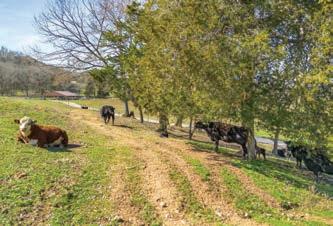

































































































EXHIBIT OPENS JULY 18






RESERVE TICKETS




The spirit, history and wonder of the garden at Wyatt Hall
AS SUMMER SETS IN, gardeners across Middle Tennessee are planting flowers, vegetables, herbs, shrubs and trees. But some gardens stand out in their significance, including at Franklin’s historic Wyatt Hall, where an English-style garden serves as both an homage to the home’s history and a blossoming sign of new life.
Wyatt Hall, a late-Federal-style home built in 1800, was added to the National Register of Historic Places in 1980. The home is named for Margaret Early Wyatt and her husband, Hubert Wyatt, who lived there from 1946 to 1982. About 15 years ago, Dr. Benny Woody, a veterinarian, and his wife, Alix, moved into the estate that encompasses some 11 acres of land.
While the historic home has long featured a garden, the Woodys have expanded and elevated the space, creating living art hidden in the heart of Franklin. Throughout 2024, they allowed Nfocus to visit regularly to document the garden.

THE BOUNTIFUL GARDEN of a little more than 1 acre surrounds the home, growing upward and outward, creating layers of differing textures and tones. It’s a breathing tapestry, with some plants seeking the shade of others that ascend towards the sun — an ever-evolving world somewhere between the manicured and the wild.
“When you’re in an old garden, you don’t want it perfect,” Alix says. So she tries to strike a balance, trimming things “a bit, but not too much.” “A lot of people would walk in here and think, oh my gosh, this is a mess,” she says. “But I want it to look like it just kind of happened. To me, that’s … harder to do than having everything just all manicured perfectly.”
For the Woodys, the garden is a series of natural rooms, decorated with antique cast iron benches depicting snakes or dogs; dozens of statues made of lead, zinc and bronze; and two stone Chinese foo dog statues dating back to the 1600s.
An octagonal library, simply called the Octagon, built by Benny over the course of a decade, sits near the rear of the garden and features antique windows from Chicago dating back to the 1910s and 1920s.
Much of Benny’s work is focused on the “hardscape” of the garden. He procures and restores antique statues and benches — fixtures dating to the 1800s and early 1900s — and even installed bricks that once lined the streets of Nashville.
“It anchors a garden and stuff that is going to be there,” Benny says. “And the benches, they always give me a place to sit down.”















FROM SPRING TO FALL 2024, the garden continued to change with the seasons, with the Woodys working daily to tend to the flowers and greenery — watering, pulling weeds, planting and trimming. In the process, they created new spaces, transforming grass into pebbled patches with a new seating area, or connecting the outdoor “rooms” by adding new pathways.
For the Woodys, there is no master plan. “A lot of it’s just trial and error and just seeing what looks good to my eye,” Alix says. “It just kind of evolves. I don’t have that gift of going to a drawing board and drawing it all out.”
Benny agrees: “We’re more the type who will come into a place and keep what’s there, but modify, rather than feeling like, ‘Oh, we’ve got to strip that out, we’ve got to take all that out.’”
And the work is ongoing. “You’re never done with a garden,” Alix says. “You keep modifying it, and then things die.”



BOTH THE EXTERIOR and interior of Wyatt Hall are inspired by Alix’s love of English gardens and homes.
“From the time I was a teenager, that was just what I liked,” she says. “I rarely looked at anything American. It was always basically the British country houses … that’s just what felt good to me.”
The garden is flooded with the scent of blossoming flowers, and the sound of birds and a pack of barking Shih Tzus, lovingly referred to as the Woodys’ “children.” Handcrafted and personalized wind chimes hang from trees throughout the space, whispering in the wind in memory of dogs once loved in life.
“That’s the spirit speaking to us through the wind, and the wind chime is the instrument of
the soul that’s gone,” Alix says. “There is a magical quality to these chimes. Sometimes, it can be windy and they don’t sing. Other times, they’re singing and there’s no wind. … They make me cry, and they make me smile as well.”
For the Woodys, that magic is reflected throughout the garden, which, despite being sandwiched between Franklin Road and a railroad, often feels like it’s secluded in a dream.
“It’s my spirituality,” Alix says. “You will never see me going in a church door or anything — that’s not me. It’s out here. It’s seeing the birds. It’s seeing the chipmunks running around. That’s what I love. And I just feel when I’m in sync with nature.”
The garden sees its share of animals — deer, chipmunks, butterflies and, in 2024, screaming cicadas. “You have to think of them,” Alix says. “I’m just kind of a visitor in their world.”


SOME OF THE GREENERY Margaret Wyatt planted during her residence in the house survives to this day — peonies, boxwoods, toad lilies, magnolias, yucca plants and a variety of hydrangeas.
Those historic plants are mixed in with newer additions brought in by the Woodys: elephant ears, banana trees, roses and more.
The uncertainty and impact of climate change means adaptation is required for survival, with Alix already moving toward more climateresistant plants, like abelia.
“Elephant ears take a ton of water,” Alix says, adding that they may soon need to plant other tropical plants too. “With the boxwoods, I don’t know how long we’ll get to have them. … I look around at the beautiful hollies in the field, and I think, how many other people are going to get to see this?”
With each season comes some predictability, new challenges and wonder blossoming from the earth, with the Woodys serving not as masters of nature, but as part of the life of the garden itself.
“We’re just caretakers,” Alix says. “This is just my little world I’ve made, and it just makes me feel secure and it makes me happy. Otherwise I wouldn’t go through the drudgery of being hot and dirty and sweaty. … It’s just what we love to do. It just satisfies something in me.”
WRITTEN AND PHOTOGRAPHED BY HAMILTON
MATTHEW MASTERS






















1 Hotel Nashville is a guiding force for local sustainability
IF YOU’VE EVER been stuck in traffic on Demonbreun (who hasn’t?), there’s a good chance 1 Hotel Nashville’s verdant exterior has at some point caught your gaze. Covered in English ivy, the luxury hotel offers a striking oasis in an otherwise-bustling city. Its leafy decor doesn’t just provide a visual distinction from its surroundings — it plays an active role in our city’s ecosystem, removing carbon dioxide from the air downtown. “It could clean the air in a 750-foot room seven times a day,” says Tyler Lee, executive chef for hotel restaurant 1 Kitchen.
In a market rampant with greenwashing, 1 Hotel doesn’t use gimmicks to earn business. Rather, health, wellness and nature are central to guests' experiences — upon entry, a farm stand greets you, offering fresh fruit picked from local farms. From the food you devour to the pillow where you rest your head, many aspects of your 1 Hotel stay are environmentally beneficial. 1 Kitchen’s Italian-inspired farm-to-table experience, Harriet’s rooftop ambiance and Asian tapas, and Neighbors’ nourishing snacks and beverages all offer high-quality food with minimal environmental impact. “Sustainability, to me, isn’t a feature,” Tyler says. “It’s the foundation of how we build our culinary program.”
TYLER MOVED TO Nashville in 2018 when sustainability practices were “under the radar.” Since then, 1 Hotel Nashville has become a guiding force for the movement, proudly implementing a zero-waste model. Minimal packaging, a robust composting initiative and recyclable aluminum water bottles help make this possible. Tyler attests that every kitchen corner features multiple compost bins, which are collected by The Compost Co. But the four Rs of recycling don’t stop there.
After guests enjoy their morning coffee, chefs harvest the leftover grounds and turn them into espresso syrup, which later fuels the restaurant’s ever-popular espresso martinis. The team’s desire to maximize every resource even applies to cooking scraps. For instance, Tyler and other chefs transform leftover carrot tops into a carrot salsa verde, allowing guests to savor the full flavor of the vegetable. “We’re able to build a good-quality product for ourselves, purely from something that was normally going to go to the garbage,” he says.
Through partnerships with local farmers, 1 Hotel’s culinary team carefully sources food for each restaurant and educates guests about its process. A few of these farmers include Sylvia Ganier from Green Door Gourmet and Samantha Foulks from The Farm & The Fiddle in Fly, Tenn. “Knowing that we can go to the farms, see how everything’s going, taste right off the vine, check what they’re doing in their own farming practices — making sure they align with us — has been such a blessing,” Tyler says.

IF YOU EVER get the chance to chat with Tyler, he’ll likely tell you education is a crucial part of sustainability. Through a collaboration with Urban Green Lab, a nonprofit that teaches Nashvillians how to live sustainably, 1 Hotel serves as a prime resource. The goal is to create fun, accessible experiences — and teach people things in the process. Last spring, for example, several chefs hosted a zero-waste culinary competition where they crafted delicious, creative dishes using beets as the central ingredient. “It’s never been about restriction,” Tyler says. “I think it’s more of our responsibility and pushing creativity. It allows us to be better leaders [and] neighbors overall.”
In late June, 1 Kitchen participated in Green Crab Week. The highly invasive European crustacean can destroy entire ecosystems in weeks — despite being the mere size of a $1 bill. While these pesky little creatures are destructive, they’re also delicious — inspiring 1 Kitchen chefs to incorporate them in a rich, one-weekonly green crab pasta dish.
This consistent innovation, research and improvement is central to 1 Hotel’s mission. “Sustainability really thrives on different iterations,” Tyler says. “I think the guests appreciate the honesty of progress more than a normal, polished narrative.” To see this growth in action, look no further than the property’s Certified Sustainable Gatherings, which ensure on-site celebrations are entirely waste-free. The program has taken off and continues to expand, implying a fruitful future for 1 Hotel — and the team’s fresh ideas.



TYLER IS ESPECIALLY passionate about an upcoming initiative where staff will visit with local farmers to film an informative video showcasing foods harvested locally and served at 1 Hotel restaurants. The video will be accessible via a QR code on every menu, enabling guests to discover precisely where their food is coming from.
The property’s new on-site beehives are also worthy of excitement. The two hives, aptly named “Reba” and “Dolly,” will help the local ecosystem prosper and facilitate homegrown honey in the middle of downtown. “One’s a little more feisty than the other,” Tyler says. “I’ll let you determine whether it’s Reba or Dolly.”
BY MADELEINE BRADFORD PHOTOGRAPHS BY ERIC ENGLAND


































35 years after unveiling ‘Athena,’ sculptor Alan LeQuire fills the Parthenon with inspirational figures
SCULPTOR ALAN LEQUIRE’S studio has been unusually animated this year. For months, an oversized gymnast made of steel rods, wire lath and gypsum cement arced toward the ceiling, traveling up and down on a chain hoist, as Alan and his team employed an ancient technique of enlarging by contour and cross section to create a graceful human form on a colossal scale.
Inspired by Simone Biles, this aerial acrobat silently shared airspace with similarly muscular armatures: a wiry sprinter, evoking fleet-of-
foot Tennessee State University alumna Wilma Rudolph, and a swimmer honoring waterborne Olympians Tracy Caulkins and sisters Alex and Gretchen Walsh.
In mid-June, this sculptural trio of “Soaring Olympians” vaulted from the fabrication workshop at LeQuire Gallery on Charlotte Pike to the Parthenon at Centennial Park. The sprinter, swimmer and gymnast now hang in the air, surrounding Alan’s gilded 42-foot sculpture of the goddess Athena, which turns 35 this year.
To celebrate the anniversary of Alan’s iconic “Athena Parthenos” — a replica of Phidias’s fifth-century-B.C. sculpture that once occupied the Parthenon in Athens — Metro Parks and Recreation and Centennial Park Conservancy are hosting an exhibition of new works by Alan, focused primarily on strong women. Monumental Figures, featuring 24 new three-dimensional works, debuted June 13 in the public spaces of Nashville’s Parthenon and outside on park grounds, and will be on display through Sept. 21.

Including the faster-higher-stronger triptych of “Soaring Olympians,” the Monumental Figures exhibition features four main groupings, starting with a colossal portrait of Fannie Lou Hamer at the east doors. When the community organizer and activist delivered testimony at the 1964 Democratic National Convention about her struggle to register to vote as a Black woman, young Alan LeQuire was paying attention. Painted to simulate gilding, Alan’s gleaming homage to the trailblazer sets the tone for another grouping inside the Parthenon’s colonnade, where 10 sculptures flanking Athena honor women whom Alan admires and considers role models. These “Monumental Women” feature:
Dr. Mildred Stahlman, pioneering neonatology researcher at Vanderbilt University Medical Center and longtime family friend, who gave Alan one of his first sculpture commissions.
Dr. Dorothy Brown, Meharry Medical College professor, the first Black female surgeon in the Southeast, and the first Black woman elected to the Tennessee General Assembly.
Sifan Hassan, winner of the marathon at the 2024 Paris Olympic Games.
Diane Nash, legendary civil rights activist.
Odetta, folk and blues singer known as “the voice of the Civil Rights Movement.”
Joan Baez, Rock & Roll Hall of Fame inductee and civil and human rights advocate.
Alongside these cultural heroes, Alan presents four groupings of everyday women, cast in the colossal scale worthy of a Greek deity, to remind viewers of the monumental significance of all people, beyond the headline names of history.
The treasury of the Parthenon features a fourth grouping, “Complete and Unbroken” — a series of 10 larger-than-life human torsos exploring ancient sculpture and the human figure.


In addition to Monumental Figures, the Parthenon is hosting Goddess in Progress, a behind-the-scenes exploration of the development and construction of “Athena Parthenos,” in the East Gallery through April 19, 2026.
“The Parthenon continues to be a valuable example of experimental archaeology, offering both students and scholars the opportunity to experience the art and architecture of ancient Greece firsthand,” says Alan, who was a 26-year-old graduate student when he won the nationwide competition to sculpt the Parthenon’s central icon in his hometown. It took eight years of extensive research, modeling
and construction — with ongoing consultation by ancient Greek sculpture specialist Brunilde Sismondo Ridgway — to complete the piece. The unpainted statue was unveiled in 1990. And 12 years later — after significant fundraising — gilding and painting were completed to create the icon as it stands today.
“The project was the completion of my training as a sculptor,” Alan says. “I feel very fortunate to have had this experience with Greek art and the Nashville Parthenon.”
BY CARRINGTON FOX PHOTOGRAPHS ERIC ENGLAND























Henry County, Ga., is an ideal spot for outdoorsy adrenaline junkies
HENRY COUNTY, GA ., is less than an hour’s drive southeast of the Atlanta airport, and it’s probably best known as the home of the Atlanta Motor Speedway. The 850-acre complex hosts two weekends of the NASCAR Cup Series each year, along with car shows, concerts and other events. Thanks to the popularity of the track, there are many lodging options in Henry County in the four main towns of McDonough, Stockbridge, Locust Grove and Hampton.

VISITORS CAN SCHEDULE tours of the Atlanta Motor Speedway by calling the racing facility. The experience includes a visit to a luxury suite and three laps around the track in one of the Speedway’s vans — with stops at Victory Lane and the garages. The Speedway is also the hub of many other outdoor adventures at either the track or the adjacent airport. One such adventure? The Bobby Ore Stunt Driving School, which trains military and law enforcement professionals in precision driving and specialized skills, like sliding 90-degree turns, controlled 180-degree spins, and evasive maneuvering. Bobby Ore has been a stunt driver for TV and films for decades and has trained countless actors and stunt professionals in the art of safe reckless driving.
Some of Bobby’s students return to teach at his school, with classes held several times a year at the Atlanta Motor Speedway. Options range from a 2-hour ride-along with a professional driver to instructional courses that last 1 to 3 days. No matter which class you take, you’re guaranteed to raise your heart rate and burn some rubber.

FOR A SLIGHTLY MORE placid experience, head to the Atlanta Speedway Airport, where you’ll find Tier-1 Helicopters. In addition to flight training, professional pilots offer private tours for up to three passengers. Available itineraries include flights over the speedway, tours of The Walking Dead filming sites, and sunset excursions of the county that can take you to the edge of Atlanta.
The airport at the speedway is also the permanent home of the Army Aviation Heritage Foundation & Flying Museum, a remarkable organization that preserves the history of military aviation and maintains a fleet of Vietnam-era helicopters and one fixed-wing observation plane. Headquartered in Henry County, the AAHF also has chapters in St. Louis and Mesa, Ariz. Volunteers offer tours of their air park hangar, where they meticulously restore and maintain the fleet of Bell AH-1F Cobra and Bell UH-1H Iroquois (“Huey”) helicopters.
Visitors hear stories of the roles these aircraft played during the Vietnam War, where the Huey was a critical utility vehicle for transporting troops through the jungle and rescuing wounded soldiers from the battlefields. The Cobra was the first helicopter classified as a “weapons platform,” and the fast and agile gunship carried an array of armament ranging from machine guns to missiles. This made it an integral tool for close air support and armed escort missions.


NOT ONLY CAN visitors to the AAHF see historic flying machines up close, but they can actually experience what it was like to fly in combat during one of the organization’s “Living History Flight Experiences.” Trained pilots fly the aircraft to air shows to participate in flyovers and offer demonstration rides. But even better are the scheduled ride days that take place about once a month from the Speedway.
The Cobra is designed for combat, so it can only carry one passenger at a time as the pilot simulates an intense attack run. You’ll sit directly in front of the pilot as he takes the copter through the sorts of tight turns and full-throttle maneuvers that the Cobra was uniquely designed to accomplish. The Huey can hold up to 10 passengers at a time, and the four souls brave enough to sit strapped next to the open doors can actually “hang ten” with their toes as the powerful aircraft recreates a wartime mission. The throbbing engine and wind rushing through the doors can lead to a bit of sensory overload — until you remember brave troops experienced this before being dropped off in a rice paddy or on the jungle floor.
The history rides only last about 10-15 minutes, but the adrenaline rush makes it feel much longer. More importantly, the opportunity to better appreciate and understand what army aviators and soldiers undertook for their country should last in your memory forever.
BY CHRIS CHAMBERLAIN PHOTOGRAPHS COURTESY OF VISIT HENRY COUNTY, GEORGIA





































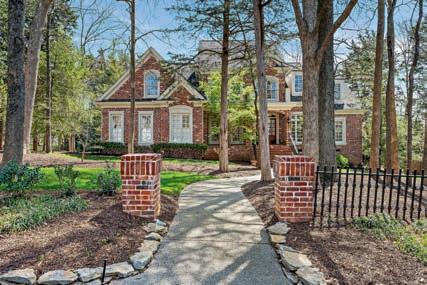









Protecting Tennessee’s wetlands to conserve the future
RUNNING ALONG BUSTLING highways and tucked into forested mountains, Tennessee’s wetlands are prolific — and crucial for our ecosystem. The state boasts 1.8 million acres of wetlands, which act as filtration systems for waterways and provide natural habitats for everything from invertebrates to songbirds to mammals. Quietly working away, these wetlands are vital for conserving greenspaces and preventing land erosion.
WETLANDS ARE LARGE or small areas of land that are covered with water or have water just below the surface. The plants that grow in these areas — known as hydrophytes — have adapted over time to thrive in wet, low-oxygen conditions.
Wetlands are also habitats, teeming with fauna that serve as food, cycle nutrients and keep the ecosystem healthy. Wetlands — and their continued existence — are crucially important to the well-being of greenspaces, protecting against destructive flooding, filtering pollution and replenishing the groundwater supply.

TENNESSEE IS HOME to a full — and varied — spectrum of wetlands. Most run along rivers and streams, feeding from or draining into larger bodies of water. But you’ll also find isolated wetlands — unique ecosystems that aren’t directly connected to other waterways.
Bottomland Hardwood Forests
Found primarily in floodplains along rivers and large streams, bottomland hardwood forests are seasonally flooded forests dominated by hardwood trees, like oaks, hickories and sweetgums. These rich habitats support a diverse range of wildlife, from amphibians to migratory birds, and are particularly valuable for maintaining biodiversity in river systems.
Scrub-Shrub Wetlands
These wetlands are dominated by woody vegetation less than 20 feet tall, such as alders, willows and buttonbushes. Often found at the edges of lakes, streams and ponds, scrub-shrub wetlands serve as important transition zones between aquatic and forested environments. They provide nesting grounds for songbirds and offer refuge for reptiles and amphibians.
Characterized by grasses, sedges and wildflowers, wet meadows remain saturated for much of the growing season, but they’re rarely flooded for long periods. These open, sunny wetlands are especially important for pollinators and ground-nesting birds. They often occur in low-lying areas, along stream banks or in abandoned agricultural fields undergoing natural regeneration.
Among the rarest wetland types in the Southeast, mountain bogs occur in highelevation areas with poor drainage and acidic soils. These peat-rich wetlands support a unique mix of plant life — such as sphagnum moss, ferns and carnivorous plants — and are critical habitats for several endangered species. Many are threatened by development, invasive species and climate change.
These seasonal wetlands form in shallow depressions, filling with rain and snowmelt during winter and spring and drying up by summer. Though temporary, vernal pools are vital breeding grounds for amphibians, like salamanders and frogs, which rely on the absence of fish to protect their eggs and tadpoles. These wetlands also support a wide array of invertebrates and cycle nutrients for surrounding forests.






































EVEN WITHIN NASHVILLE’S borders, wetlands abound — often quietly nestled in parks, on school campuses or along greenways. These local ecosystems not only support native wildlife, but they also offer Nashvillians an opportunity to engage with nature, right in their own backyards.
Located along the Cumberland River in East Nashville, the wetlands at Shelby Bottoms Nature Center and Greenway offer a striking example of how urban conservation can thrive. This bottomland habitat features seasonal wetlands, wooded swamps and wet meadows — all of which support a rich mix of flora and fauna. Visitors might spot great blue herons wading in shallow waters, turtles sunning on logs, or red-winged blackbirds calling from cattails. The wetlands here also serve as a natural buffer during heavy rains, soaking up floodwater and purifying runoff before it reaches the river.
Tucked between Tennessee State University’s agricultural fields and the nearby floodplain lies the lesser-known — but ecologically significant — Tiger Bay Wetlands. This low-lying area often fills during rains and supports a mix of scrub-shrub and wet meadow habitats. Used for hands-on environmental science research by TSU students, the site is a working example of how urban campuses can integrate greenspace into their infrastructure. The wetland not only provides a critical habitat for amphibians and pollinators, but it also serves as a living classroom for future conservationists. In April, our sister publication, Nashville Scene, profiled TSU students studying and working to restore the Tiger Bay Wetlands.
In a quiet corner of the University School of Nashville’s River Campus campus lies a pocket-sized wetland project that proves ecological education doesn’t require a massive footprint. Originally developed for a student-led sustainability initiative, the wetland captures stormwater from the surrounding neighborhood and filters it through native wetland plants, like sedges and rushes. It’s a model of how small-scale interventions can make a measurable impact on water quality and urban biodiversity. Students monitor everything from water levels to insect populations, making this a thriving mini-laboratory for urban ecology.
BY JANET KURTZ
PHOTOGRAPHS BY ANGELINA CASTILLO AND COURTESY OF FRIENDS OF SHELBY BOTTOMS



























































Three landowners work with the Land Trust for Tennessee to conserve local greenspaces
NASHVILLE IS AN ever-budding metropolis. With nearly 80 to 100 people moving to the city per day, its soundscape is incomplete without the roar of construction. But let this not distract us from the rolling hills, grassy terrain and abundant wildlife Tennessee is known for. Through the Land Trust for Tennessee, several private landowners have protected these natural pockets of serenity — and the legacies they carry.
Since 1999, the Land Trust has preserved the distinct character and history of Tennessee landscapes. Through con-
servation easements, land acquisitions and community-focused projects, the organization protects 137,000 acres of land across 76 counties.
While the Land Trust uplifts stunning properties, it also celebrates landowners. The passionate individuals behind these plots add immeasurable value, infusing their distinct personalities into the very land they nurture.
Nfocus visited with three of these landowners to discuss their work with the Land Trust to preserve the spaces that keep Middle Tennessee green.





IF KAREN GUY invites you over to her lush, serene property, she’s bound to show you the sights with excited fervor. With farming equipment from the 1920s, a restored red barn and an aerial property map from around 1937, Hunter’s Hill Farm brims with glimpses of days gone by. “I have an intense love for this place,” Karen says. “I know every rock and tree.”
Despite rapid commercial expansion in Davidson County, sweet spots of undeveloped nature and rich history remain. Hunter’s Hill Farm is one such place. Andrew Jackson owned the land from 1797 to 1804 before moving to the property now known as Andrew Jackson’s Hermitage. His granddaughter, affectionately known as Little Rachel, raised Karen’s great-grandfather. Hunter’s Hill has always played a pivotal role in Karen’s family, as her great-aunt and great-uncle passed the farm — and its legacy — down to her. These historical ties are the crux of the land, where Karen has lived since 1979. Hunter’s Hill spans 178 acres and features a mile and a half of lakefront property on the Cumberland River. Karen’s palpable love of nature urged her to connect with the Land Trust and protect her property in 2007, which has since earned Greenbelt status. And in 2018, her sister, Judy Guy, protected her farm in Wilson County, which has been in the same family for seven generations. “I saw what was happening around me,” Karen says. “I just don’t think I could have stood it if this ground was bulldozed and houses were built.”
While receiving an appraisal to justify land conservation is an accomplishment in itself, maintaining Hunter’s Hill is a collaborative process. Karen spearheads logistics and livestock care but outsources assistance with lawn upkeep. When not working on the farm, Karen’s land-focused pursuits overlap with her hobbies, which include gardening, searching for arrowheads and trail riding with her horse. Much of her contentment stems from being connected to her farm. “I think a lot of problems with people’s depression and unhappiness is [that] they’re so far removed from the land,” Karen says. “The land gives you soul and purpose.”
Since 2007, Hunter’s Hill has exemplified nature’s restorative qualities and its ability to foster community.
“I knew that this place is special,” Karen says. “It’s a healing place. You get a good feeling when you come here, and you feel like you’ve gone back in time. And I think people need that.”











JOHN KINNIE JR.’S property is perhaps one of the most peaceful and secluded in Williamson County. For miles and miles, there isn’t a house in sight — only vibrant grass, flourishing trees and meticulously planted row crops.
Protecting prime farmland with the Land Trust didn’t just ensure John’s property would remain untouched — it further cemented the Kinnie legacy. John’s grandparents bought the property right before the Great Depression. And from childhood, John developed his profound love of the great outdoors there. The farm has been his home for his entire life — 81 years, to be exact. “My grandparents worked hard on it,” John says. “And they were always trying to be conservation-conscious. We’ve always worked to save the soul.”
John turned to the Land Trust for support in 2022. He placed 139 acres of land into a conservation easement, which ensures the space will remain undeveloped in perpetuity. With his brother and sister owning and operating individual portions of the family farm, the total land amounts to an impressive 500 acres. John made sure to protect his portion and hopes to conserve more property with the Land Trust in the future. “This is as home as it gets,” he says. With a roughly “165-head cow-calf operation” and nearly 120 acres designated for row crop farming, there’s never a dull moment. And even when John isn’t working on the farm, he still enjoys its scenery. “If I’m not on a tractor somewhere or working with a cow, I just like to be there, listen to nature, watch the trees and the grass grow, hear the birds and watch the wild turkeys and my deer,” he says.
His conservation efforts have further preserved the land’s environmental benefits, like producing crops and providing clean air. “This country needs open [land] to produce food for us,” John says. “I don’t want to see it just grown up with houses. Since this is a unique piece of property, it just means a whole lot to me.”
When looking toward the future, John hopes more landowners will be encouraged to protect their properties with the Land Trust, as he did. “This is my heaven on Earth right here,” he says.



PAST A CANOPIED, tree-lined street outside downtown Franklin lies Emily Magid’s private oasis. The property’s tranquility and stunning scenery drew Emily in when she first viewed the land. “I came across something on a Sunday,” she says. “I went and looked at it. I bought it that Thursday.” After making the space her home, she nurtured her passion for conservation. “I knew that when I moved here, I never wanted it developed,” Emily says.
As Franklin becomes an increasingly sought-after city to live in, protecting natural greenspaces has become an even bigger priority for private landowners. “There’s 300 acres next door to me, and they just sold it to a developer,” Emily says. “They are going to drop a small city in the middle of a cow pasture with absolutely no infrastructure.”
Emily preserved her Greenbelt property with the Land Trust in 2007, emphasizing that, after she passes, she wants her land to be donated to Walden’s Puddle, a nonprofit rehabilitation and rescue center. “It appealed to me, because I knew that the property would be safe,” she says. “It would always be at least 72 acres of pristine land.”
And pristine land, it is. Beautiful landscaping, intricate gardening and shaded walkways make the space a welcome sanctuary from the rest of the city. When at home, Emily enjoys sitting on her porch, listening to her wind chimes and looking out at the pond in her front yard. “I’m in nirvana,” she says. “It is just a fabulous place, and I’m so happy to be here.”
Her dedication to preservation propels her philanthropic work, where she serves as a board member for multiple organizations, including the Heritage Foundation of Williamson County, Harpeth Conservancy, Walden’s Puddle and Friends of Williamson County Animal Center. “I’m not on these boards just to be on a board,” Emily says, chuckling. “I’m a worker bee.”
When reflecting on her land and its history, Emily glows with appreciation. “There’s so much development, and here we were in this perfect little alcove,” Emily says. “I have always loved being out in the open.”
BY MADELEINE BRADFORD PHOTOGRAPHS BY ERIC ENGLAND AND HAMILTON MATTHEW MASTERS



Boutique Spa
Need a Summer Slimming Boost? Utilize the latest technology, along with your healthy diet and exercise plan, to target specific areas, or to tone and tighten.
Sculpt, Slim and Smooth at TIBA!



Weight loss, detoxification, improved circulation, and workout recovery are just a few of the benefits of the Solo Carbon Far-Infrared Chromotherapy Sauna bed!
Indulge in our European slimming treatment using a cocoon of warm whipped paraffin and the oil of the Caribbean Frangipani flower. Best in a series of three to five sessions. So relaxing, skin so ening, and hydrating!


Celluma Full Body or Specific Area Light Therapy reduces fat within adipose cells and improves body circumference and skin appearance. Non-invasive, painless and can be used safely on all skin types!
Shape up with Ballancer Pro Lymphatic Drainage Compression Therapy! Combines lymphatic drainage with stateof-the-art shaping techniques through compression massage.

For appointments and gift cards call -
Full menu of services at ShopTiba.com Open 10-6, Monday-Saturday In Berry Hill West Iris Drive • Nashville, TN
Dedicated to enhancing the beauty, confidence and health of Nashvillians for over 40 years.





Swan Ball plants a willow oak to commemorate its rst event bene ting Friends of Warner Parks
SINCE THE INAUGURAL Swan Ball in 1963, patrons and guests have received thoughtful swan-themed souvenirs — silver trivets, vases, books, tote bags and glass bowls — to recall the splendor of unforgettable galas.
In the “I Spy” game of identifying Swan Ball totems in Nashville’s loveliest rooms, some relics are obvious, like the square plate engraved to mark the 40th anniversary. Others are more subtle, like the unmarked postmodernstyle picture frame designed by architect and former honoree Michael Graves. This soigné archive — including paperweights, salad servers, wildflower seeds, wine glasses and martini pitchers — provides the passport stamps in a journey of festivities surrounding the Patrons Party, Late Party and main event on the Swan Lawn at Cheekwood.
In this year’s new location, Edwin Warner Park, the Swan Ball team took a new approach to the favors. In lieu of individual presents, co-chairs Melanie Baker and Laura Niewold proposed a single collective gift to honor supporters of the event. Working with the naturalists at Warner Parks, the volunteers planted a willow oak tree in honor of the 63rd Swan Ball, which benefited Friends of Warner Parks’ efforts to maintain Edwin and Percy Warner Parks and the Nature Center.
“The willow oak reminds us of a swan,” said Melanie, who walks frequently in the parks and enjoys exploring trees with tribute plaques throughout the forests and fields. “When guests came out of the glass tent in that magical meadow, they saw on the hillside a tree planted in their honor. And they’ll see it whenever they walk the park in the future.”
BY CARRINGTON FOX PHOTOGRAPHS BY HAMILTON MATTHEW MASTERS































































































































































e 2025 Swan Ball pulses with renewed energy
EACH SPRING THROUGHOUT the Warner Parks, as the snow melts and the frozen ground thaws, the whisper of renewal rises. Tender saplings and verdant flora push through the frost and stretch toward the sun. This year, Edwin Warner Park hosted a different kind of rebirth — the reimagining of the annual Swan Ball — a symbol of the city’s social landscape.














In 1963, prolific philanthropist Jane Dudley launched a fundraiser to support the then-struggling art institution Cheekwood. That year, the Swan Ball was born. On June 18, 1963, The Tennessean reported that the ball raised $26,000 — approximately $271,000 today — for the art museum and gardens, solidifying its place as a cornerstone event on Nashville’s social calendar. Each spring after, Nashville’s most elegant donned their finest white-tie attire and gathered on the Swan Lawn of Cheekwood Estate & Gardens.
Throughout the decades, teams of co-chairs — assisted by armies of volunteers — worked tirelessly to create not only a special evening, but a brand built on philanthropy and community support.
Then in 2024, a new story began — as so many things do in Nashville — with a bold decision made in a great pair of shoes. Swan Ball 2025 would be a departure in every sense — off the Swan Lawn, out of the box and into the wild. The event had entered a new era. For the first time in its history, the Swan Ball moved to Edwin Warner Park and benefited Friends of Warner Parks, a nonprofit that raises crucial funds for the city’s beloved greenspace.
This dauntless and risky move was co-chaired by Melanie Baker and Laura Niewold, who led the transformation, working diligently with event planner Dori Thornton of The Social Office to set a new course and cement the event’s place in Nashville’s social legacy. Dance Committee chairs Sterling Akers and Catherine Bradbury did a masterful job coordinating a team of volunteers to escort ladies and open doors between the cocktail and dinner tents. Late Party chairs Emily Mitchell and Carly Simington ensured an energetic and flawless transition between the ball and the Late Party.









































As guests arrived at Harpeth Meadows in Edwin Warner Park, the Swan Ball emitted palpable new energy. The night smelled like honeysuckle — not roses, though there were plenty. And the sound of laughter permeated and refreshed the atmosphere, intensified by a chorus of cicadas and crickets chattering in the night. Revelers marveled at a striking steel-and-glass structure, accented with fuchsia bougainvillea, that marked the entrance to the cocktail reception. Guests enjoyed hors d’oeuvres by Kristen Winston Catering, Champagne and cocktails as they mingled beneath the golden light of sunset. Many paused to admire the décor before heading into the dinner tent, where more delights awaited.
In the dining room, floral displays by Knestrick by Design topped long tables. In the center of the room stood a giant blossoming tree whose canopy spread over diners seated below, creating an enchanting environment. The excitement in the room was hard to contain — a hallmark of all the Swan Ball events this year — and reached fever pitch before the first award was given or the first note of live music played.
Swan Ball board co-chairs Elizabeth Nichols and Kathryn Brown took the stage to thank everyone for their support. They acknowledged 2025 had been a year of transformation that would carry the Swan Ball’s legacy into the future. They also noted the important work of beneficiary Friends of Warner Parks. “As Nashville continues to grow and change, the parks remain a treasured sanctuary for our neighborhoods and for the broader community,” Kathryn said. “Preserving them is more important now than ever — a gift not just for our children, but for generations to come.” To honor that sentiment, in lieu of traditional favors, the co-chairs planted a willow oak tree for all guests of the park to enjoy.
They also honored philanthropist and jewelry designer Brooke Garber Neidich with this year’s Swan Award, which recognizes someone who contributes greatly to humanity through service. Brooke owns the luxury jewelry brand Sidney Garber and donates her annual profits — totaling over six figures — to philanthropic causes.
Then, it was time for the entertainment. Each year, the Swan Ball showcases some of the era’s most notable performers to bring even more caché to the event, and 2025 was no different. At 81, Grammywinning icon Patti LaBelle didn’t just take the stage — she lit it up. Her voice, still thrilling, turned the tent into a full-blown celebration. With each familiar chorus, the crowd sang louder and swayed harder. More than one guest jovially kicked off their designer shoes and danced barefoot. And by the time Late Party band Blue Rhythm took over, it was clear — the Swan Ball had not lost its soul. It had simply found a new place to take root and bloom.
BY JANET KURTZ




















































































































The Swan Ball Auction Party delivers an actionpacked evening of fundraising


For the past year, Swan Ball 2025 co-chairs Melanie Baker and Laura Niewold have worked tirelessly to reimagine the spring season’s signature white-tie gala. The dedication was evident to all of the elegantly dressed guests who arrived at Belle Meade Country Club for the Swan Ball 2025 Auction Party. Party chairs Mamie Murphy (a newly minted Nfocus Fresh Face of Philanthropy) and Julia Spickard — along with auction chairs Suann Davies, Emily Humphreys and Sarah Reisner — were doubly industrious, bringing the event to life with remarkable energy and attention to detail.
Before the bidding began, guests mingled over mini beef Wellingtons, pimento cheese toast points, and charming cones of truffle fries. On the spring evening, ladies in floral frocks and gentlemen in sharp suits gathered on the patio for cocktails and ventured inside to view the auction items.
Event planner, lifestyle expert and comedian Hugh Howser played the role of emcee, warming up the crowd before auctioneer Jamie McDonald took the stage. Within moments, the crowd erupted into enthusiastic bidding. Guests bid high and bid often on lots like a private jet and estate experience in Cabo San Lucas, a Bahamian paradise on Great Abaco Island, a trip through Croatia and Montenegro, and a meet and greet with Swan Ball 2025 entertainer Patti LaBelle. The silent auction was equally robust, offering an Argentina dove hunt, a New York City tour with artist Michael Shane Neal, an art and caviar experience with artist Ed Nash, and more. In all, the auction featured 18 domestic trips, 16 international trips, 26 unique experiences and 10 fabulous treasures — many of which were sold at the live auction.
BY JANET KURTZ PHOTOGRAPHS BY ERIC ENGLAND
























The Great Futures Gala celebrates achievements by the Boys
Members of the Boys & Girls Club of Middle Tennessee believe “leadership starts young.” That’s something Eric Higgs, president and CEO of BGCMT, emphasized — and revelers fully embraced — at this year’s Great Futures Gala.
Since 1903, BGCMT has provided educational programs that help students increase confidence, find community and develop leadership skills. These resources aren’t merely empowering — they also address the generational literacy challenges many students face. Through its focus on this issue, the organization has helped club members achieve a 100% high school graduation rate and an 82% college graduation rate.
For BGCMT kids, the future looks bright. And every aspect of the Great Futures Gala, co-chaired by Jensen Sessums and RJ Stillwell, reflected this. Cheerful students greeted guests, pointing them toward the main festivities. A three-course dinner followed a jovial cocktail hour, where attendees chatted and browsed auction items. But the most memorable part of the evening occurred when three student emcees of varying ages took the stage.
Emcees Kaleel, LaNaiya and Weisler reflected on BGCMT’s impact, sharing their aspirations for the future. After declaring how proud he is to be a member, Kaleel received a standing ovation from all 550 people in attendance. “America needs club kids. Nashville needs club kids,” he said. “But club kids need you today.”
The energetic auction — with a prize list that included student-made art, tropical vacations and even a Cavalier King Charles Spaniel puppy — raised ample funds for BGCMT scholarships and memberships. To lift spirits even higher, Grammy-winning country trio Lady A topped off the night with a performance. Acoustic guitar and sweet-sounding harmonies filled the room, inviting many guests to rise from their seats and dance.
BY MADELEINE BRADFORD PHOTOGRAPHS








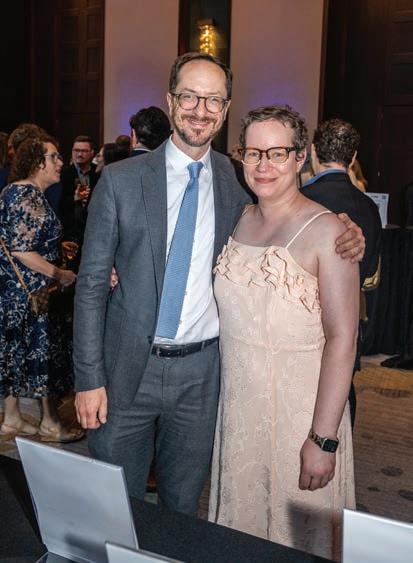



































The Legacy Ball Patrons Party celebrates a future in education
On a showstopping spring evening, guests arrived at the elegant home of Yvette Boyd for the Legacy Ball Patrons Party. The evening was a chance for organizers to thank donors and supporters and to reemphasize the R.H. Boyd Family Foundation’s mission to empower the community by providing scholarships to students and supporting organizations that offer educational advancement to those in need.
Throughout the evening, friends mixed and mingled as excitement built for the upcoming event. Co-chairs Maya and John Faison and Tiffany and Alfred Degrafinreid took the front of the room — co-chair Michael Eric Dyson was there in spirit — with LaDonna Boyd, R.H. Boyd president and CEO. LaDonna reminded everyone of the foundation’s important work. “Not only are we giving back to education and grants, but [we are] making sure that we’re honoring African American achievement as well,” she said.
As speakers took turns highlighting the foundation’s important work and the ongoing importance of Historically Black College and University scholarships, it soon became clear that most of them held doctorates. Touched by this, community supporter Apphia Maxima asked who in the room had an advanced degree. In that powerful moment, the important mission and vision of the Legacy Ball became abundantly clear — as most stood or raised their hands.
LaDonna shared more good news : The foundation’s signature fundraiser, the Legacy Ball, was already 80% sold out with less than a month to go. Last year, while LaDonna was getting her hair done for the ball, she received calls asking if there were any seats left at the event. The answer was “no.” She joked that this year, she wouldn’t be taking those calls — and encouraged everyone to buy their tickets early.
After the speeches and thank-yous concluded, many stayed to celebrate and enjoy an evening of friendship.
BY JANET KURTZ PHOTOGRAPHS BY MICHAEL SCOTT EVANS











































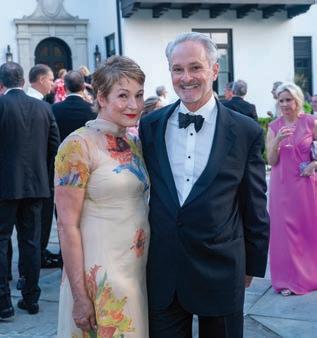










The Swan Ball Patrons Party sets the scene for a metamorphosis
It is said that a butterfly goes where it pleases and pleases where it goes. The metaphor may be well-worn, but on this night, it felt entirely earned. There was a vibrancy to the effervescent evening at Kim and Jeff Leeper’s home for the Swan Ball 2025 Patrons Party — an event that captured the beauty of transformation in full color.
Guests arrived to the melodious sounds of a string quartet perched on the front drive of the home. Friends visited while enjoying cocktails and delicious hors d’oeuvres by Kristen Winston Catering. Even the gentlemen — forced into black-tie attire for the umpteenth time this spring — found themselves breaking a smile or cracking a joke.
Inside the home, Brooke Garber Neidich of Sidney Garber — the official Swan Ball Jeweler — set up a stunning display of her work, tempting guests to try on a pair of eye-catching earrings or a dazzling necklace. As is usual at this event, it was hard to tear guests away from the jewelry table.
Inside the dinner tent, event planner Amos Gott created an apt — and elegant — butterfly motif. Wide fabric sashes covered with colorful butterflies draped across the ceiling, while other butterflies playfully dotted the dinner plates and menus. The theme was fitting in more ways than one: It nodded to beneficiary Friends of Warner Parks’ work to replace invasive plants with pollinator-friendly species, and it also spoke to the transformation of the Swan Ball itself.
While no one said it out loud, there was a question of what life the ball would take on this year. The Underwriters Party and the Swan Ball Auction Party had completely hit numbers out of the park — not just achieving, but exceeding, all budgeted goals and offering fun experiences that kept guests talking for days. With this in mind, guests left the beautiful evening — with visions of butterflies projected on the front of the Leepers’ home — excited to watch the event grow into something new.
BY JANET KURTZ PHOTOGRAPHS BY ERIC ENGLAND






































At Amazon, we look to leverage our scale for good to help strengthen local communities. That means combining our strengths with those of community partners, working together to find creative solutions that have a lasting impact. Thank you to Nfocus’ Fresh Faces of Philanthropy Honorees for your impact in the community.





Nfocus celebrates the second class of Fresh Faces of Philanthropy


On a picturesque summer night, revelers in Nelson’s Green Brier Distillery raised a toast to the new class of Nfocus’ Fresh Faces of Philanthropy. These 12 honorees represent the next wave of Nashville philanthropists and changemakers. Through their hard work and the honorable causes they support, these trailblazers prioritize dedication and generosity. And in true Nfocus fashion, they also know how to bring the party. The room — filled with family, friends and past honorees — buzzed with excitement and well-deserved congratulations.
The garden-party-esque evening, presented by Amazon, swept guests into a blooming sanctuary upon arrival. Beautiful floral arrangements by Rose Hill Florists complemented Nfocus’ colorful June issue — copies of which dotted the space. Classical arrangements by Viva La Strings Nashville added to the soirée’s chic, elegant feel.
Many guests hopped into the Nfocus portrait studio, sponsored by Luxe & Luna Boutique Spa, where their faces glowed against a backdrop of lush greenery and intricate paper flowers. After moving into the main room — decked out with large-scale magazine covers featuring each of the honorees — attendees mingled over cocktails and enjoyed tasty bites, including strawberry bruschetta, fresh vegetables and herbed pita crisps.
Nfocus editor-in-chief Janet Kurtz took the stage, where she eloquently welcomed the second class of Fresh Faces of Philanthropy and emphasized its impact. “When we say ‘Fresh Faces,’ we don’t just mean new — we mean next,” she said. “They represent what’s next in philanthropy, leadership and impact.” Janet then presented each honoree with a custom plaque including their photo and feature from the June issue.



This year’s event also debuted the first-ever Nfocus Impact Award, presented by Pinnacle Bank, which Janet awarded to cover girl Morgan Huelsman. The Impact Award presents an opportunity for each Fresh Face to have deeper engagement with their cause, and it recognizes the person who sells the most tickets to the event. To honor the awardee, an additional donation is made to whichever organization they represent.
Crystal Churchwell Evans, Kayla Clayborne Counts, Fred Crumbo, Ann Waller Curtis, Virginia Fitzgerald, Morgan Huelsman, Hayley Levy Kupin, Mami Murphy, Alexandra Nelson, Ben Scott, Daniel Weisman and Jeffrey Welk are not only easy to celebrate — they’re exceptional leaders. As guests began to disperse, the room brimmed with conversation about each individual’s accomplishments and what they’ll continue to achieve.
BY MADELEINE BRADFORD PHOTOGRAPHS BY ERIC ENGLAND AND HAMILTON MATTHEW MASTERS









































Thank you to all of our sponsors, partners and wonderful attendees for another great year of Fresh Faces of Philanthropy!

THANK YOU TO OUR SPONSORS! Congrats to our 2025 Impact Award Winner Morgan Huelsman on behalf of Abe’s Garden Community















































The fourth annual Legacy Ball is a hit
History, legacy and an eye on Nashville’s future all played central roles in the R.H. Boyd Family Foundation’s fourth annual Legacy Ball. As guests arrived at the Schermerhorn Symphony Center, servers greeted them with shining silver trays topped with wine and Champagne. The celebratory mood continued as guests mingled and stopped by the event’s portrait studio to capture memories of the evening.
Once the dinner chimes sounded, guests quickly made their way to the Laura Turner Concert Hall. Master of ceremonies Jonathan Slocumb — the “clean comedian” — immediately caught the attention of the crowd. Within minutes, the audience was laughing openly and listening intently. “I want to remind you all that this is more than an event,” Jonathan said. “It’s a movement to keep the legacy alive and thriving.”
Co-chairs Michael Eric Dyson, Tiffany and Alfred Degrafinreid, and Maya and John Faison built upon Jonathan’s core message. “Tonight, we come together to honor a legacy that was born out of resilience and rooted faith,” Maya noted. Her husband, John, agreed, directing the conversation toward the organization’s future. “A legacy isn’t just about looking back — it’s about what we do next,” he said. “We’re here to celebrate, yes, but also to invest in the next chapter — a chapter that honors our ancestors while equipping our children, a chapter where culture and community meet faith and forward thinking.”
Perhaps the most poignant moment of the evening came during the annual R.H. Boyd awards presentation. Each honoree represents service to others and a personal commitment to give back to the community. The R.H. Boyd Humanitarian Award recognized Forrest Harris, president of American Baptist College. The R.H. Boyd Service Award went to the beloved Rosetta Miller-Perry, publisher of the Tennessee Tribune. And the R.H. Boyd Excellence Award honored Bobby Jones, an esteemed gospel singer, television host and radio broadcaster.
The crowd danced late into the night — honoring the evening’s commitment to celebrate legacy, as well as to preserve and build upon it.












BY JANET KURTZ PHOTOGRAPHS BY ALLEN CLARK PHOTOGRAPHY AND DANIEL MEIGS Penny












































Stay tuned for our panel announcement.

Tickets are on sale now for our annual luncheon, where we celebrate the accomplishments of some of Middle Tennessee’s most prominent female business and philanthropic leaders.
Experience meaningful connections and networking, a panel with distinguished female leaders in Nashville, a VIP hour with complimentary headshots and more. In this discussion our panelists discuss their hard-won wisdom and experiences. We also honor our Nfocus Model Behavior honorees and celebrate ten female philanthropists who give their time, talent and treasure to support and lift up local nonprofits.
















THERE’S NO DOUBT ABOUT IT — Tennessee summers are gorgeous, yet brutal. In fact, a classic Tennessee summer would not be complete without scorching temperatures and all-encompassing humidity. But despite these truths, the state’s lush, green landscapes know just how to draw citizenry into the heat and transform them into happy Nashvillians.
To see this annual recurrence in action, look no further than Warner Parks — some of the largest municipally administered parks in the state. Percy Warner Park opened to the public in 1927, with Edwin Warner Park following suit in 1937. Pristinely maintained, these greenspaces still set the scene for memorable moments, including weddings, lively soirées and, of course, this year’s Swan Ball. And it’s little wonder why. The verso on the following postcard — dated between 1907 and 1914 — reads as such:
“Warner Park, just beyond the city limits, contains 2,550 acres and many miles of beautiful drives and enchanting bridle paths and pleasant foot walks. This park is noted for its natural scenery, consisting of rugged, hilly Middle Tennessee countryside that has been undisturbed by the hand of man.”
BY MADELEINE BRADFORD PHOTOGRAPH COURTESY OF THE NASHVILLE PUBLIC LIBRARY


